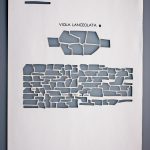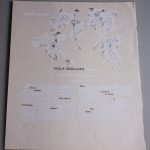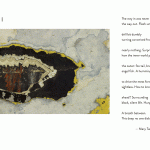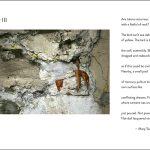Termination Shocks by Janice Margolis
University of Massachusetts Press, 2019
Paperback, 258 pages, $13
Famous Children and Famished Adults by Evelyn Hampton
FC2, 2019
Paperback, 160 pages, $13
Sooner or Later Everything Falls into the Sea by Sarah Pinsker
Small Beer Press, 2019
Paperback, 288 pages, $17



There is a familiar and sort of empty phrase that we come across from time to time in blurbs and reviews. This book left me wanting more. It’s an odd notion. Applied to novels, it’s essentially unfathomable: what more could be asked of Moby-Dick—Ishmael’s intervening years? Or Invisible Man: do we need “Part 2: Still Down Here in the Coal Bin”? Perhaps, while only seeming to laud, the critic-reviewer is giving a sneaky backhand, and that I want more actually implies there’s not enough here.
Maybe when applied to collections of short stories and poems, the phrase “this book left me wanting more” has somewhat sturdier—if still wobbly—legs. Perhaps the reader–critic enjoys the author’s use of language or metaphor so greatly that reading even more would simply be lovely . . . so, really, all that’s happened is that the critic–reader has tapped into his pleasure principle. Or maybe it’s something else; maybe it’s the setting of the scenes or the fascinating characters that entrance our reader–critic: a bit dulled by his own daily life spent watching baseball and eating Doritos, he’d prefer to linger in the well-imagined fictional setting, in a space richer and with people more interesting than those in his own poor surroundings. But if that’s the case, it’s not so much that the critic–reader wants more of the book—the poor fella just wants less of his current existence.
Left me wanting more. When describing authors’ first books, it takes on even trickier meaning (because if we don’t want more now . . .). As luck would have it, under review here are three such debuts: Termination Shocks by Janice Margolis, Famous Children and Famished Adults by Evelyn Hampton, and Sooner or Later Everything Falls into the Sea by Sarah Pinsker. Having read all three, I can honestly say one thing. I want more.
Quick admission: a few years ago, a collection of mine received the Juniper Prize. While Termination Shocks has also received the Juniper Prize, I don’t know Janice Margolis, and my current ties to UMass Press are more or less non-existent. That’s not a complaint, just a fact. UMass is an academic press, and it doesn’t have the family feel that many literary presses strive for. My point is that there’s no conflict of interest in my discussion of Termination Shocks.
I began Termination Shocks with hopeful anticipation. Here was a book chosen for its prize by Sabina Murray, a talented writer interested in language, tone, and structure. And the book begins strong—the first of its five stories, “21 Days,” is impressive in its reach. The story is a feverish first-person history of Liberia as told through the point of view of an orphan stuck in her family hut for Ebola quarantine in the days following the death of her mother. The title refers to the length of her quarantine, and the story foregrounds language, form, and meaning (social commentary) over plot and even characterization. Here a rat has as complex a characterization as the narrator’s romantic interest, or her teacher, or her mother (it’s a cool rat). Margolis relays the narrator’s experience cleanly and beautifully:
Everything crackles inside me. I could be made of lightning. A dying bird beats against my brain, swoops between my ears, pecking songs Mama sang me. It makes the notes bleed between my legs, and I cut the gold-and-green dress into beautiful rags to catch the falling sounds.
Of course, the situation Margolis has chosen to write about is one of intensity, sorrow, and fear, and the narrator’s feverish reveries lead to wonderfully revelatory moments, such as, “[My teacher] tells me how animals groom each other in the most vulnerable positions. How humans groom each other with language. Miss Browne grooms me for hours.”
“21 Days” is a beautiful work. And it does raise questions of appropriation, too—a white American author writing about a Liberian girl possibly stricken with Ebola. But to my reading, the story seeks authenticity, and it tries to dramatize the moment in brutality more than in beauty; the only villains are, if anyone, the white medical staff. It’s a challenging story to read and a challenging story to write, and credit goes to Margolis for taking the challenge on.
After “21 Days,” I read the second story in the collection, “Being Tom Waits.” This is a story narrated by a person who has become Tom Waits. I know very little about Tom Waits. He seems to need a shave. And I like the song about Singapore. But I also feel that what I enjoy about Tom Waits is not what fans of Tom Waits enjoy. This did not interfere with my enjoyment of the story. If you want to read a story version of Being John Malkovich transferred to the mind of Mr. Waits, here you go, minus the scheming plot. We are immersed fully in the head of the fictional Tom Waits. The story is plotless, but no matter—it’s funny, irreverent, referential, absurd, and loving:
Speaking of Normal Mailer, he and I had a brief correspondence in the ’70s. For some reason, a fan letter I’d written gave him the impression I was a tall dirty blonde. I didn’t disabuse him of his mistake, and allowed a non-existent part of my body to be described in a particularly lascivious exchange he later insisted was meant for Gloria Steinem. As requested, I destroyed the letter, which, as a lover of history, I deeply regret.
Incidentally, am I the only one who notices that incessant ringing?
The story veers between confused recollection, wanderings of Los Angeles, Waits’s frustrations, paranoias, conceptual albums, lost genitals, and more. Between it and “21 Days,” my expectations for the final three stories in Termination Shocks were considerable, but the returns diminish a bit. The fourth story in the collection is narrated by the Berlin Wall, an interesting concept that becomes a bit static (and very removed from the present day). The concluding title story is another structural experiment, wedding the stages of rocket liftoff with personal relationships; by the story’s end, the design feels more scattered than accumulative. The collection’s middle story, “Little Prisoners,” is an interesting outlier: a 170-page novel-length piece written as straight realism, even as historical fiction, following an archaeology student in Syria who falls in with government protesters and becomes accused of spying, which leads ultimately to a big reveal about her past.
Termination Shocks is an odd collection that creates, at its best, wonderful literature. It features two challenging, strange stories—one risky and rewarding, and the other inanely effusive and immersive. While the final two stories also lean toward innovation—of structure, of concept—they, and certainly the very long “Little Prisoners,” don’t quite match the sheer ambition and exuberance in the first two pieces. It’s fair to say that the collection left me wanting more.
In her debut Famous Children and Famished Adults, recipient of the FC2’s Ronald Sukenick Innovation Fiction Prize, Evelyn Hampton includes quite a few stories: twenty-two that collectively span just 160 pages. Given the stories’ relative brevity, it’s only logical that this is a very different book from Termination Shocks, especially in terms of the foregrounded fiction elements. Rather than progressive narrative tensions (“plot” is a four-letter word here), or characters existing over long periods of time feeling the deep impacts of upsetting life events, the stories in Famous Children and Famished Adults are swifter, stranger, and more concerned with language and the mindsets of their many strong-voiced narrators. These stories are elusive in terms of being plot-reducible; that the collection was chosen as FC2’s Sukenick prize-winner by Flournoy Holland is no surprise, since she is a writer as much immersed in mood and the line and deep evocations of point of view as anything else. Hampton’s fiction seems very Holland’s type of fiction.
Which is great. It leads to the publication of stories like Hampton’s, works that push against the familiar. It’s hard to group the collection: these are stories as glimpses, hints at strange characters in stranger relationships—and we’re only ducking in to watch them a few moments. This is seen often, in stories such as “Choo and Cream” (a couple joined together by a “a nearly transparent child who clapped its hands not out of glee or approval, but because of the awkward way its body was dangling”); “The End of History” (a nameless female narrator “wants to discover . . . a framework for her content”); “Every Day an Epic” (among other things, we learn that the narrator has “been looking at the world through a lens,” enters into it, and “open[s] intervals and unravel[s] across them”); and many more.
There’s a slightly tendency in Famous Children and Famished Adults toward the surreal parable in metaphorical situations that explore more mundane experiences (“Choo and Cream” could be read as a metaphorical description of what it’s like to have a newborn). But even that tendency isn’t very pronounced; more than anything, it’s easier to say what isn’t in the collection. Throughout, Hampton shows an impatience for context and clarity, which makes the normal experience of fiction—enjoyment, emotional impact—a bit hard to come by. One piece, “At the Center of the Wasp,” goes thusly: someone who bottled and sold scents has died; there’s an island that is either literally or figuratively made of shit; the dead person has to be buried; the narrator doing the burying (and complaining all the while about the shit and the island and the smell and burying) is related to the dead person. The story is an effusion of frustration with context barely provided; it’s like stepping onto an elevator with a person on a cell phone engaged in a furious conversation you cannot quite piece together. Which can be enjoyable and meaningful, especially if you sit back and enjoy the lines, the point of view, the strangeness.
“At the Center of the Wasp” lies at the far end of the collection; most of the stories have a bit more clarity, and the strangeness shines rather than muddies. In “Cell Fish,” the narrator learns that her significant other is dying, and Hampton tells this story through elision rather than a more predictable head-on style. Her patience and ability to let white space do work is admirable, as is her ability to let small gestures convey tone, character, emotion: “The doctor pressed her fingers together, enclosing the space in front of her face. When she spoke, the voice seemed to come from the space enclosed by her hands.” Rather than pursuing the story into the territory we might generally expect—hospitals, progression of disease, the impact on day-to-day life—Hampton more often keeps us caught in the impending doom rather than stepping into the more familiar literary ground of the doom itself. This is a harder task; with most writers, it’s not intuitive. That Hampton prefers in her fiction to move us into—and to remain in—those quiet spaces before the dam breaks is impressive and admirable.
A great thing about story collections is that they rest on their strongest pieces. For me, the greatest works in Famous Children and Famished Adults are the ones that, perhaps begrudgingly, do allow more narrative context. A bit of familiarity, for me, makes strangeness even stranger, as it allows situation, voice, and language to become more uncanny rather than entirely uprooting the reader. The story “Jay” is the easiest example: the narrator’s friend, a possible spy, has vanished from her life, and we see the impact of the two’s strange interactions play out over a longer period of time. Other stories, too, give us more context: “Fishmaker,” “Cell Fish,” “The Slow Man,” “Since All the Cats have Vanished,” for instance, let the reader in a bit more and so, at least for me, have greater impact. At its best, Famous Children and Famished Adults is a successful, unique, and commanding collection, though sometimes it’d be nice to get a larger picture of a given story’s disaster, a larger sense for how it plays out on the characters’ lives. Just a little more.
Sarah Pinsker’s debut, Sooner or Later Everything Falls into the Sea, is less like the other two collections here under review. Foremost, it’s not a contest winner chosen by an academia-established literary author; rather, it’s published by Small Beer Press, an indie known for works that, while literary, lean toward the fantastic. It’s no surprise that the stories in Sooner or Later Everything Falls into the Sea were previously published in genre-aligned journals including Asimov’s Science Fiction and Lightspeed. While Hampton and Margolis certainly feature experimental-leaning fictions, their works are, at least to me, a more familiar type of literary experimentation—more academic than commercial.
I opened Sooner or Later Everything Falls into the Sea with a feeling I had when I was much younger and reading books not as a writer but simply as a reader, with no expectations, no hopes or skepticisms, no begrudging or apprehension. Pinsker’s stories only magnified my childlike sense of excitement and wonder: the worlds they contain are imaginative, vivid, and well-designed, almost like Cornell boxes—vividly adorned and other-worldly while still being tilted versions of our own. “A Stretch of Highway Two Lanes Wide,” about a young man who loses an arm in a work accident, sadly and poignantly captures the longing, interestingly, of his replacement robotic arm:
It didn’t just want to be a road. It knew it was one. Specifically, a stretch of asphalt two lanes wide, ninety-seven kilometers long, in eastern Colorado. A stretch that could see all the way to the mountains, but was content not to reach them. Cattleguards on either side, barbed wire, grassland.
Other stories throughout the collection twin the surreal with the poignant ordinary. “Remembery Day” features an annual parade for military veterans; the twist is that on this day, the veterans vote whether or not to lift their “Veil,” a perpetual forgetting of their war traumas. In “No Lonely Seafarer,” a genderless narrator confronts sirens who have laid waste to a town’s shipping industry. “Wind Will Rove” asserts the need for people to hang onto the seemingly unimportant textures of their shared history—especially while stuck on a spaceship adrift in the universe. The title story features a scavenger who finds a woman stranded ashore in a boat; we learn from a slightly unwieldy narrative style that the lost woman was living, as many do in the story’s world, on a cruise ship, playing bass in a house band that exists to entertain the privileged wealthy. In the quietude of the scavenger’s abode, we see a collision between consumerism (the musician) and being a hermit (the scavenger), between a life of accumulation and a life, if lacking in material things, more attentively lived.
The stories in Sooner or Later Everything Falls into the Sea remind me in style, tone, and world-construction of the stories collected in Ray Bradbury’s The Illustrated Man; this is true of their thematic underpinnings, as well. If Evelyn Hampton’s stories lean toward the parable, Pinsker’s don’t lean so much as announce meaning via loudspeaker. As with Bradbury’s, these are message-driven works of fiction. Their intricate architectures are often overlaid onto moralistic messages, and at times this serves to reduce the stories’ emotional valence. There are cautioning moments, as well. “The Low Hum of Her” is implicitly a Holocaust story in which a father has built for his daughter a replacement robotic grandmother; this story, too, is poignant, as the daughter begrudgingly comes to love the robot, but as the story doesn’t once mention the horrible sufferings of the Holocaust, the fraught setting seems almost whimsically chosen.
Of course these aren’t boxes—they’re stories, ranging from as brief as three to as long as forty-plus pages. But to carry the Cornell comparison further, as with the artist’s famous boxes, the stories in Sooner or Later Everything Falls into the Sea rely on the reader to infer from or project emotional complexity upon their dazzling arrangements, and as we gaze at the design elements, some of the more literary elements—especially character complexity—get shorter shrift. For a debut collection, Sooner or Later shows remarkable promise—if only the real complex human stuff of it were given a little more attention.
One last side-note: while these three collections are very diverse in terms of form and craft, it’s important to observe diversity of both voice and represented experience, as well. Other than “21 Days,” I’m not sure these collections are expanding diversity in those ways. These are three very white collections, very middle class. That’s just an observation, not a criticism. Of course, writers can only write best what writers can only write best, and Janice Margolis, Evelyn Hampton, and Sarah Pinsker are writing awfully damn good fiction. There is plenty here—plenty to admire, to envy, and to praise. These three collections are pushing against the ordinary, pushing against the familiar (if imaginary) line that wraps neatly around what fiction, what literary fiction, should be.
And they should be pushing against that line; they should be pushing against any expectations. That’s what we should expect from these books given to us by such innovative and important presses. While the reader–critic in me thinks, I really hope Pinsker/Hampton/Margolis goes out now and writes a greater novel with more emotional impact, the teacher–writer part of me rolls his eyes and disagrees. Shut up, critic–reader. To hell with your notion that fiction should conform to your expectations. You’re not in charge. They are, these three talented authors. Let them keep on doing their work. They’re doing a great job—well more than enough.


![Body of The [strikeout text] Fairy Tale.](https://cah.ucf.edu/floridareview/wp-content/uploads/sites/34/2019/10/Sirmans-image-1024x713.jpg)















